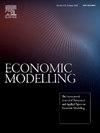气候变化、国家能力和不平衡增长:对印度的分类分析
IF 4.7
2区 经济学
Q1 ECONOMICS
引用次数: 0
摘要
本研究考察了气温上升对印度长期经济增长的影响,包括不同地区、行业和季节的总体和分解水平。现有的研究主要依赖于汇总估计和面板数据,不足以解决异质性、温度动力学和潜在的传输机制,特别是在分类水平上。利用面板数据估计了一个横截面增强自回归分布滞后模型(CS-ARDL),该模型捕获了特定州的天气输出关系、长期影响、温度持久性、年内变率、未观察到的异质性和跨区域溢出。研究结果显示,年平均温度变化1°C会使经济增长减少3.89%,几乎是先前估计的两倍。其次,研究结果表明,年温度变化通过降低生态系统服务、劳动力和资本效率来破坏生产力,从而降低了增长。第三,国家能力在形成区域对温度冲击的脆弱性方面发挥了调节作用。第四,影响具有异质性,因季节(冬季较大)、地区(南部和较热地区较大)和部门而异。本文章由计算机程序翻译,如有差异,请以英文原文为准。
Climate change, state capacity and uneven growth: A disaggregated analysis of India
This study examines how rising temperatures affect India’s long-term economic growth, both at aggregate and disaggregated levels across regions, sectors, and seasons. Existing research has predominantly relied on pooled estimation with panel data that inadequately address heterogeneity, temperature dynamics, and underlying transmission mechanisms, particularly at disaggregated levels. A cross-sectionally augmented auto-regressive distributed lag model (CS-ARDL) is estimated using panel data that capture state-specific weather-output relationships, long-term impacts, temperature persistence, intra-annual variability, unobserved heterogeneity, and cross-regional spillovers. The findings reveal that, on average, a 1 °C annual temperature variation reduces economic growth by 3.89%, nearly twice the previous estimate. Second, results suggest that annual temperature variation diminishes growth by damaging productivity through reduced ecosystem services, labour, and capital efficiency. Third, state capacity plays a moderating role in shaping regional vulnerability to temperature shocks. Fourth, impacts are heterogeneous, varying by season (greater in winter), region (higher in southern and hotter regions), and across sectors.
求助全文
通过发布文献求助,成功后即可免费获取论文全文。
去求助
来源期刊

Economic Modelling
ECONOMICS-
CiteScore
8.00
自引率
10.60%
发文量
295
期刊介绍:
Economic Modelling fills a major gap in the economics literature, providing a single source of both theoretical and applied papers on economic modelling. The journal prime objective is to provide an international review of the state-of-the-art in economic modelling. Economic Modelling publishes the complete versions of many large-scale models of industrially advanced economies which have been developed for policy analysis. Examples are the Bank of England Model and the US Federal Reserve Board Model which had hitherto been unpublished. As individual models are revised and updated, the journal publishes subsequent papers dealing with these revisions, so keeping its readers as up to date as possible.
 求助内容:
求助内容: 应助结果提醒方式:
应助结果提醒方式:


